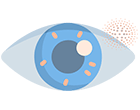Optic Atrophy Precision Panel
Optic atrophy is the clinical manifestation of any disease process causing axon degeneration in the retinogeniculate pathway. Particularly, these diseases affect the retinal ganglion cells and their axons forming the optic nerve, which are in charge of transferring the visual information from the photoreceptors to the lateral geniculus in the brain.




